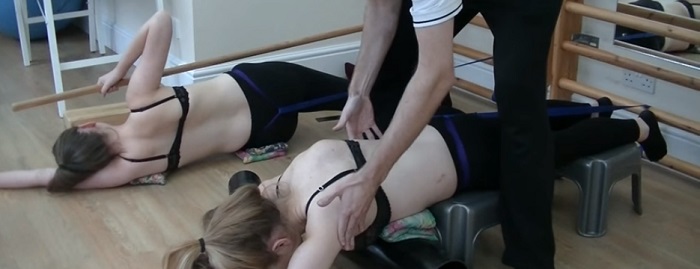
Idiopathic scoliosis (which usually arises during puberty, when the body is going through a period of rapid growth) is often treated using a rigid back brace that prevents the spinal curve from progressing as the patient grows. It's important to note that the aim of this bracing treatment is not to correct / reverse the sideways curvature of the spine, but simply to stop it from getting worse until the body has finished growing.
And while bracing can be very effective in that respect, it does very little to assist in building up the muscle strength that will be needed to ensure spinal stability once the brace comes off.
In fact, bracing tends to have a negative effect on muscle strength.
Scoliosis braces typically have to be worn for over 20 hours a day in order to achieve the best treatment outcome. During the bracing period, the muscles around the spine are likely to become inactive because the brace is doing their job (i.e. supporting the spine) for them.
This often results in a weakening of the spinal muscles, which may lead to the patient becoming reliant on the support of the brace.
But physical therapy can help with this problem.
There is a lot of clinical evidence to suggest that bracing delivers better outcomes for the patient when combined with scoliosis-specific physiotherapy. A 2011 study1 found that combining these two approaches reduces the risk of future curve progression and thus the likelihood that spinal fusion surgery will eventually be required. It has also been shown2 that completing a scoliosis-specific exercise programme limits the reversal of spinal correction when bracing ends.
Not only are scoliosis-specific exercises recommended in the SOSORT 2011 guidelines for people with adolescent idiopathic scoliosis who are undergoing brace treatment, but several authors who developed scoliosis braces (such as the Milwaukee, Boston, Lyon and Chêneau braces) have proposed that scoliosis-specific exercises should be used to complement brace treatment. Indeed, the newly-developed Sforzesco and Gensingen braces are specifically designed to be worn in conjunction with exercise-based therapy.
In short: it's good to receive physiotherapy for your scoliosis even if it's also being treated with a brace. Integrating scoliosis-specific exercises with a bracing treatment helps to provide a more complete rehabilitation programme for growing patients with idiopathic scoliosis.
Our Treatment Methods > Book a Consultation >
Links & References
- ScolioGold Therapy - The Scoliosis SOS Clinic's own combination of proven exercise-based scoliosis treatment techniques
- Contact Scoliosis SOS - Arrange an initial consultation (to be conducted at our clinic in London or via Skype / telephone)
1. Negrini S, Aulisa AG, Aulisa L, Circo AB, de Mauroy JC, Durmala J, Grivas TB, Knott P, Kotwicki T, Maruyama T, Minozzi S, O'Brien JP, Papadopoulos D, Rigo M, Rivard CH, Romano M, Wynne JH, Villagrasa M, Weiss HR, Zaina F: 2011 SOSORT guidelines: Orthopaedic and Rehabilitation treatment of idiopathic scoliosis during growth. Scoliosis 2012, 7:3
2. Zaina F, Negrini S, Atanasio S, Fusco C, Romano M, Negrini A: Specific exercises performed in the period of brace weaning can avoid loss of correction in Adolescent Idiopathic Scoliosis (AIS) patients: Winner of SOSORT's 2008 Award for Best Clinical Paper. Scoliosis 2009, 4(1):8.